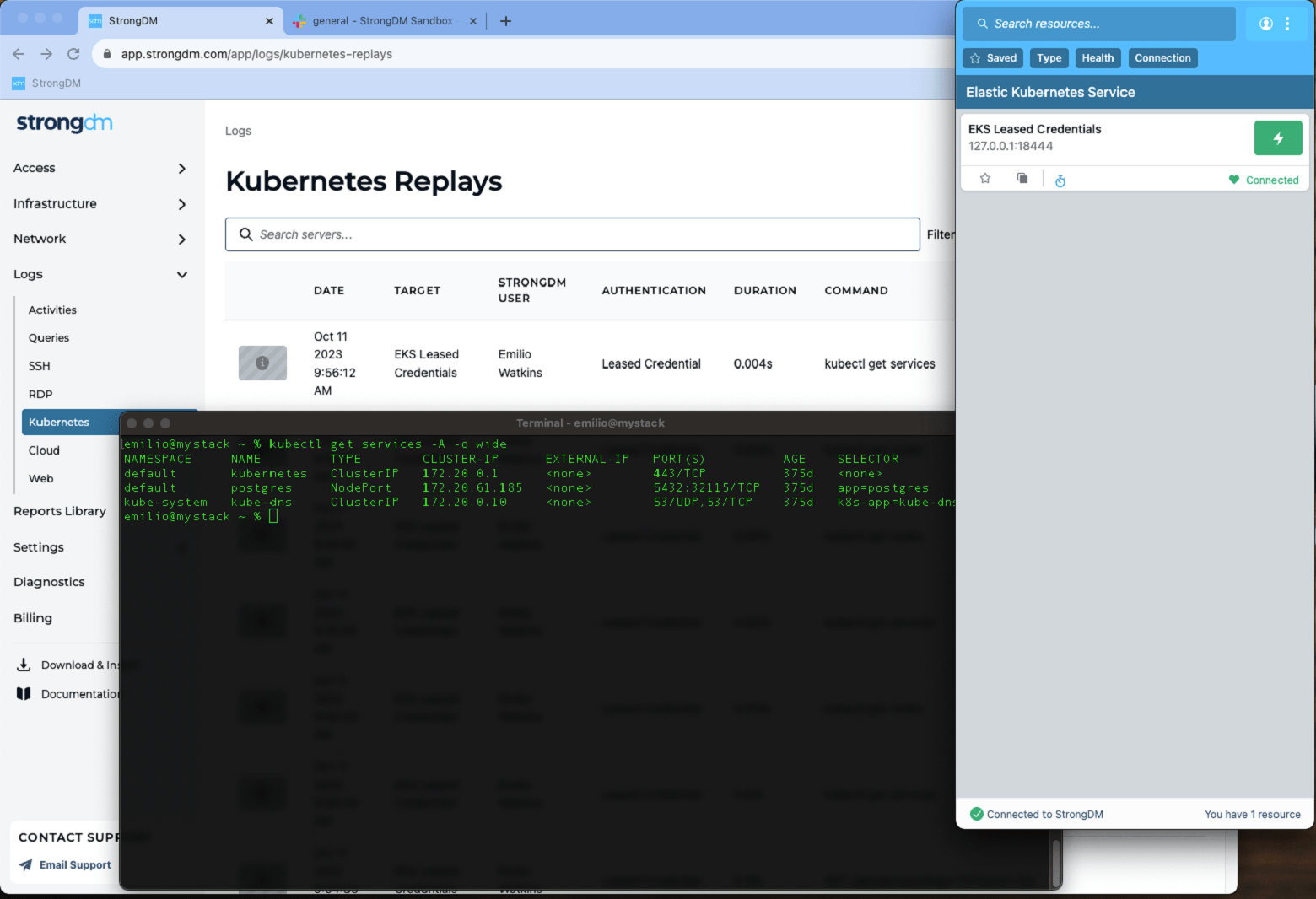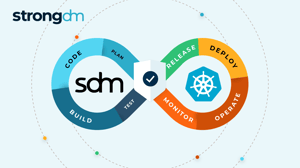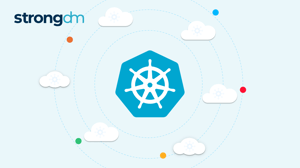
- Role-based, attribute-based, & just-in-time access to infrastructure
- Connect any person or service to any infrastructure, anywhere
- Logging like you've never seen

Managing Kubernetes effectively requires more than just knowing how to spin up pods and nodes. As organizations scale their containerized applications, the need for robust, secure, and user-friendly tools becomes critical. From access control to observability and cost optimization, this list covers the best Kubernetes management tools to help you master your clusters.
Whether you're a platform engineer, security lead, or platform architect, these tools can make a measurable difference in how you deploy, monitor, and secure your infrastructure.
1. StrongDM: Best for Secure Infrastructure Access & Auditing

If you’re looking for comprehensive, role-based access to Kubernetes environments—alongside other infrastructure—StrongDM is the trusted choice for both security and DevOps teams. Rather than replacing your Kubernetes tools, StrongDM secures and streamlines them.
StrongDM has redefined Kubernetes access by combining zero trust principles, fine-grained policy control, and developer-first workflows into a solution that balances security with usability. Unlike traditional PAM tools or static RBAC models, StrongDM secures Kubernetes clusters with real-time, policy-driven access—without slowing down your DevOps team.
How StrongDM secures Kubernetes clusters:
- Automated Cluster Discovery: Say goodbye to manual YAML configs. With Helm-based auto-registration, StrongDM detects new clusters automatically and registers them under centralized access management, eliminating security blind spots.
- Just-In-Time (JIT) Privilege Escalation: Enforce least privilege by granting temporary, context-aware admin access with automatic expiry. All access is logged and policy-validated—no standing privileges.
- Cedar-Based Policy Engine: StrongDM’s dynamic policy engine leverages Cedar to enforce precise, context-rich access decisions. Whether it's the trust level of the device, the geographic location tied to an IP address, the user's identity and role, or the time of access—every factor contributes to fine-grained, just-in-time authorization aligned with Zero Trust principles.
- Automated RBAC Discovery for JIT Access: StrongDM continuously discovers RBAC principals and their privileges across your infrastructure, automatically mapping roles, bindings, and permissions in real time. This dynamic visibility empowers the platform to generate precise Just-in-Time access requests and enforce context-aware policies—minimizing misconfigurations, reducing manual effort, and eliminating privilege creep.
Watch how easy and secure it is to request and manage access to Kubernetes clusters using StrongDM's Just-in-Time access workflow: - Access Approvals (with the right amount of friction): Integrated directly with Slack, Jira, and Microsoft Teams, StrongDM lets developers request Kubernetes access in their daily workflows. Admins can approve with a click.
- Multi-Cloud & Hybrid Support: Manage access consistently across AWS, Azure, GCP, and on-prem Kubernetes environments—all governed by a single policy engine.
- No Credential Sharing: Kubeconfigs and tokens are never exposed. StrongDM uses ephemeral credentials, drastically reducing the risk of leaked secrets.
- Audit-Ready Logging: Every action—access request, command run, session replay—is recorded. This supports SOC 2, HIPAA, PCI-DSS, and NIST compliance.

Real-World Use Cases
- Secure Troubleshooting with JIT: DevOps engineers can instantly elevate access for incident resolution, request approval via Slack, and auto-revoke access after a set time. Example walkthrough
- Cluster Group Discovery at Scale: Security teams get real-time visibility into all Kubernetes resources, users, and groups across environments. RBAC group discovery guide
- SaaS Integration-Ready: Whether it's Okta, ADFS, Snowflake, or Redis, StrongDM extends secure Kubernetes access to cloud services without configuration drift. Explore integrations
StrongDM doesn’t manage clusters or deploy containers—it secures access to them. That’s what makes it the perfect complement to the other tools on this list.
👀 Want to see how it works in action? Watch the Kubernetes Access Control Webinar.
2. Lens: The Kubernetes IDE for Devs and Operators

Lens makes Kubernetes development capabilities accessible with a sleek desktop app. It's ideal for teams that want a GUI for multi-cluster management, serving over 1 million users worldwide as the most popular Kubernetes IDE.
As a comprehensive development environment, Lens transforms complex Kubernetes operations into intuitive workflows, enabling both developers and operators to manage clusters with unprecedented ease. Its real-time monitoring capabilities and built-in troubleshooting tools make it an essential platform for teams scaling their Kubernetes environments across multiple clouds and on-premises deployments.
Highlights:
- Graphical view of pods, workloads, and services
- Built-in terminal with kubectl support
- Resource metrics from Prometheus
3. K9s: Terminal-Based K8s UI

Prefer the command line? K9s gives you a fast, keyboard-driven interface to navigate, inspect, and manage cluster resources. This terminal-based UI continuously monitors your Kubernetes environments for changes, offering real-time visibility and efficient cluster management through an intuitive command-line experience.
Highlights:
- Real-time log tailing
- Interactive resource dashboards
- Lightweight and blazing fast
4. Portainer: User-Friendly Kubernetes & Docker Management

Portainer offers a clean, browser-based UI to manage Kubernetes and Docker environments. Perfect for small to mid-sized teams, this open-source platform simplifies container orchestration through an intuitive interface that abstracts away complexity. Whether you're managing Docker standalone instances, Swarm clusters, or Kubernetes environments, Portainer provides a unified management experience that helps reduce operational overhead and accelerates container adoption.
Highlights:
- Container lifecycle management for logs, stats, and real-time console access
- YAML and UI-based deployment
- Multi-environment support
5. Rancher: Multi-Cluster Management at Scale

Rancher is the leading open-source platform built for enterprises managing multiple Kubernetes clusters at scale. It abstracts infrastructure complexities, enforces consistent security policies, and provides a unified control plane for managing any certified Kubernetes distribution—from on-premises deployments to cloud services like EKS, AKS, and GKE. With centralized authentication, advanced monitoring capabilities, and integrated CI/CD tools, Rancher streamlines cluster operations while reducing operational overhead across your entire Kubernetes ecosystem.
Highlights:
- Centralized management of EKS, AKS, GKE, and on-prem clusters
- RBAC and SSO integration
- Helm chart catalog integration
6. Octopus Deploy: CI/CD for Kubernetes

Octopus Deploy helps DevOps teams streamline and automate application deployments to Kubernetes clusters through reusable, template-driven workflows. Its powerful environment progression capabilities and built-in deployment templates make it an ideal choice for organizations looking to standardize their Kubernetes deployment processes while maintaining complete visibility and control over their release pipelines.
Highlights:
- Multi-step deployment pipelines
- Environment promotion workflows
- Integration with GitHub Actions, Jenkins, etc.
7. Argo CD: Declarative GitOps Delivery

Argo CD is a powerful GitOps continuous delivery tool that ensures your Kubernetes clusters reflect the state defined in your Git repositories—automatically and securely. As a CNCF-graduated project, it has become the industry standard for GitOps implementations, helping teams automate and streamline their deployment process while maintaining complete visibility over their infrastructure changes. Whether managing single or multiple clusters, Argo CD's declarative approach eliminates drift between Git definitions and live cluster states.
Highlights:
- Sync with Helm, Kustomize, or plain YAML
- Visual app dashboards
- Automated rollbacks
8. Flux CD: Lightweight GitOps Alternative

Flux is another GitOps continuous delivery tool that excels in simplicity and scalability. As a CNCF-graduated project, it enables automated synchronization between Git repositories and Kubernetes clusters. It supports multi-tenancy and Git branching strategies, making it ideal for teams scaling their Kubernetes environments.
Flux's GitOps toolkit provides a set of powerful controllers and APIs that ensure your cluster state always matches the declarations in your Git repository, eliminating configuration drift and streamlining deployment workflows. Whether managing single or multiple Kubernetes clusters, Flux's reconciliation approach continuously monitors for changes and automatically applies updates, reducing operational overhead while maintaining security.
Highlights:
- Secure by design with minimal privileges
- Works well with VS Code GitOps extensions
- Integrates with SOPS for encrypted secrets
9. Prometheus: Open Source Monitoring Core

Prometheus remains the go-to solution for collecting and querying time-series metrics in Kubernetes environments, offering a robust foundation for monitoring container-based infrastructure. As a CNCF-graduated project, it excels at dimensional data collection, making it perfectly suited for the dynamic nature of Kubernetes clusters. Its pull-based architecture and efficient time-series database enable teams to track everything from basic resource utilization to complex application metrics, while its powerful PromQL query language allows for sophisticated data analysis and alerting.
Highlights:
- Pull-based metrics scraping
- PromQL for advanced queries
- Alertmanager for notifications
10. Grafana: Powerful Visualization for K8s Metrics

Pair Grafana with Prometheus to visualize your cluster metrics on custom dashboards. Its rich visualization capabilities and intuitive interface make it the industry standard for Kubernetes monitoring. With pre-built dashboards for common use cases and support for PromQL queries, teams can quickly set up comprehensive monitoring views. The platform excels at real-time data visualization, offering everything from basic graphs to advanced heatmaps and histograms for deep cluster insights.
Highlights:
- Cluster health overview
- Resource consumption trends
- SLA reporting with thresholds and alerts
11. Helm: Package Management for Kubernetes

Helm simplifies deployments by packaging Kubernetes manifests into versioned charts, acting as the de-facto standard package manager for streamlining application lifecycle management in Kubernetes environments.
Highlights:
- Easy upgrades and rollbacks
- Helm chart repositories
- Great for third-party apps and in-house microservices
12. Kustomize: Overlay-Based Config Management

Kustomize helps you manage YAML configurations cleanly, using overlays instead of duplication. This native Kubernetes configuration management tool lets you customize application configurations without templates, making it perfect for handling environment-specific variations while maintaining a single source of truth for your base configurations. Its integration with kubectl makes it a natural choice for teams already working with Kubernetes CLI tools.
Highlights:
- Built-in with kubectl
- Layered environments (dev/stage/prod)
- No need for templating engines
13. Istio: Secure Service Mesh and Traffic Control

Istio is a powerful, production-grade service mesh that enhances microservice communications in Kubernetes by providing comprehensive traffic management, security enforcement, and observability features. As a CNCF-backed project, it seamlessly integrates with your Kubernetes infrastructure to deliver enterprise-ready service networking capabilities.
Highlights:
- Mutual TLS for all services
- Canary deployments and A/B testing
- Fine-grained traffic control
14. OpenShift: Enterprise Kubernetes Platform

Red Hat's OpenShift delivers a comprehensive enterprise Kubernetes platform that enhances security, streamlines developer workflows, and provides production-ready container orchestration. Built on a hardened Kubernetes foundation, it combines automated operations, robust security controls, and integrated developer tools to help organizations accelerate their container adoption journey.
OpenShift stands out by offering a complete platform that includes everything from CI/CD pipelines to monitoring solutions, making it particularly valuable for enterprises managing complex Kubernetes environments at scale.
Highlights:
- Source-to-image builds
- Operator Lifecycle Manager
- Multi-cloud and hybrid support
15. Kubecost: Cost Visibility for Kubernetes Workloads

Kubecost helps teams understand, optimize, and reduce Kubernetes infrastructure spend through real-time cost allocation and automated resource management. This powerful platform provides granular visibility into cluster expenses across any cloud provider or on-premises deployment, enabling organizations to implement effective FinOps practices for their container environments.
Highlights:
- Cost per namespace, deployment, or label
- Efficiency scores and idle resources
- Budget alerts and forecasting
Conclusion
Kubernetes has evolved into the cloud’s operating system—demanding tools for access, automation, visibility, and control. Choosing the right stack is key to balancing security, scalability, and efficiency.
StrongDM acts as your secure gateway to all clusters, forming the backbone of your Kubernetes strategy. With StrongDM in place, you can build your toolchain—Argo CD for GitOps, Prometheus for monitoring, Kubecost for budgeting—without compromising security or control.
As your Kubernetes footprint grows, the right tools are essential. Want to streamline access and boost security? Start with StrongDM.
Frequently Asked Questions
What is Kubernetes management?
It’s the process of deploying, monitoring, securing, and scaling Kubernetes clusters and applications using tools for access control, observability, automation, and cost optimization.
Is Kubernetes a container management tool?
Yes, Kubernetes is a container orchestration tool that manages the deployment, scaling, and operation of containerized applications.
What are the RBAC tools in Kubernetes?
Tools like StrongDM, Portainer, and Rancher offer role-based access control (RBAC) to manage who can access Kubernetes clusters and what actions they can perform.
About the Author
John Martinez, Technical Evangelist, has had a long 30+ year career in systems engineering and architecture, but has spent the last 13+ years working on the Cloud, and specifically, Cloud Security. He's currently the Technical Evangelist at StrongDM, taking the message of Zero Trust Privileged Access Management (PAM) to the world. As a practitioner, he architected and created cloud automation, DevOps, and security and compliance solutions at Netflix and Adobe. He worked closely with customers at Evident.io, where he was telling the world about how cloud security should be done at conferences, meetups and customer sessions. Before coming to StrongDM, he lead an innovations and solutions team at Palo Alto Networks, working across many of the company's security products.

You May Also Like




